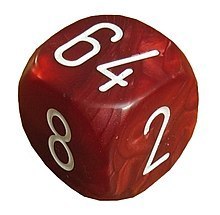
For those of you who just got their first backgammon set, you have probably noticed this strange die that doesn’t look like any others. Instead of the regular 1 to 6 printing the one on this die shows curious numbers like 2, 4, 8, 16, 32 and 64. What is this all about? No need to panic, what you have in the palm of your hand is a doubling cube. What is its purpose and how to use it?
Backgammon-Rules tell you all you need to know about the doubling cube in backgammon.
Origin of doubling cube in backgammon
The concept of doubling cube in backgammon appears at the beginning of the 20th century in the gaming clubs of the lower east side in New York. There is a lot of speculation about who invented it, but the truth is nobody knows exactly who introduced the first the doubling cube in the game. Nowadays, the doubling cube is a mandatory piece of equipment for any backgammon player who wants to fully experience the strategic side of the game.
What is the purpose of the doubling cube in backgammon?
The doubling cube has one and only function : raise the stake of a game. At the beginning of every game of backgammon, the doubling cube is placed on the side of the board showing 64. That means that it has not been used yet. Thus the players start to roll the dice and move their checkers around the board.
At some point one of the players might feel that he has an advantage over his opponent. In this case, when it is his turn to play and always before rolling the dice, a player can offer to double the stake of the game. To do so, he has to take the doubling cube and put it in front of his opponent with the face of the dice showing 2.
At this point his opponent has two options :
- Accept the cube (we call it a take), which means that now the game is worth 2 points instead of 1 ;
- Decline the cube (we call it a drop), which means that he resigns the current game and loses1 point.
Once a player takes the doubling cube, he owns it and he is the only one that can offer to redouble the stakes of the game to 4.
At the end of the game, the winner gets the number of points shown by the doubling cube.
This number has to be multiplied by 2 in case of gammon and by 3 in case of backgammon.
In certain scenarios, doubles in backgammon have additional rules that we are going to detail below.
The Crawford rule
Most of the time backgammon is played in a match format. Two players try to reach a number of points in order to win the match (the number of points is always odd).
The Crawford rule stipulates that when a player is one point away from victory, his opponent cannot use the doubling cube on this particular game (it is what we call a Crawford game).
If the match is not finished after the Crawford game, the cube can be used as normal.
The Jacoby rule
The other way to enjoy backgammon is the money play. In this case, the players don’t try to reach a number of points but they simply play one game after another independently for a stake they both agreed on. The game stops when one of the players gives up. Usually in money play the Jacoby rule is on. This rule stipulates that gammon and backgammon don’t count as such if the cube has not been turned during the game. So if you win a gammon during a money game and the cube is still in the middle of the board, you don’t win 2 points but only 1. This rule is made to speed up the game by not letting a player hoping to gammon his opponent hold to turn the cube for too long. Thus, the game is faster and more action happens because the players are eager to turn the cube early.
Knowing when to offer and when to drop a cube is an essential skill to be successful at backgammon. But I won’t lie to you, it is not easy and even masters make mistakes sometimes on the matter. The more you play, the more you know when it’s the right moment to offer the cube and to see your opponent scratch his head not knowing what to do. We advise you to get familiar with using the cube from the beginning as it brings a big strategic part to the game we all love so much. Stay tuned for more articles about strategies and equipment on backgammon-rules.com. Have fun around the board and may the dice be with you.


I have been practicing with the doubling cube in mind. I think of real backgammon players who have won and lost fortunes like Omar Sharif the famous and great Egyptian actor.
I will endeavor to win more fortunes than lose.